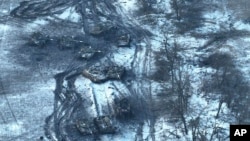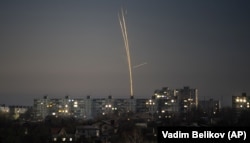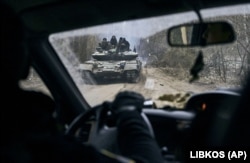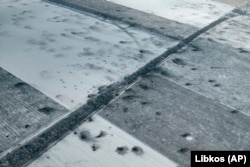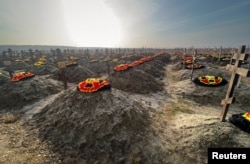For weeks if not months, Ukrainian military and political leaders, along with some Western intelligence officials, have warned that Russia is preparing for a major new offensive.
Cold temperatures had dialed down the tempo of fighting while both sides replenished their manpower and materiel, positioning equipment, digging trenches, rebuilding units -- preparing for the war’s next phase.
Live Briefing: Russia's Invasion Of Ukraine
RFE/RL's Live Briefing gives you all of the latest developments on Russia's full-scale invasion, Kyiv's counteroffensive, Western military aid, global reaction, and the plight of civilians. For all of RFE/RL's coverage of the war in Ukraine, click here.
That new offensive now appears to be under way, with Russian forces in eastern Ukraine building on months of intense localized assaults in several places in an effort to regain momentum in their sputtering, yearlong invasion.
The intensifying clashes come as the February 24, 2022, invasion nears the one-year mark and Russian forces struggle to achieve even President Vladimir Putin’s least ambitious goals.
“The Russian military has likely begun offensive operations and these are early attacks and early efforts to seize positions,” Michael Kofman, a Russia director at the Center for Naval Analyses, a U.S.-based think tank, said in a podcast on February 7. “These look like the very early phases of it.”
Putin has shuffled commanders at least three times to try and improve the military’s checkered performance to date.
Ukrainian officials, Western intelligence, Russian and Ukrainian military bloggers, and other open sources all indicate that Russia has intensified assaults in multiple locations over the past week -- in particular near Kreminna, in the western part of the Luhansk region, and in Vuhledar, to the south of the city of Donetsk.
This latest phase of the war may herald a return to one of the Kremlin’s original stated priorities: complete control of the Donbas, parts of which have been occupied by Russia-backed forces since 2014.
“The enemy is trying to take full control of Donetsk and Luhansk oblasts,” Ukraine’s General Staff said in a February 9 post on Facebook.
Meanwhile, there are indications that Ukraine is girding for potential offensives as well -- possibly on the southern front in the Zaporizhzhya region, for instance -- but they do not appear to have begun.
Here’s what you need to know about how the battlefield is evolving.
Aerial Barrage
Russia unleashed the latest in a series of missile and drone barrages across Ukraine on February 9, hitting targets like electrical grid infrastructure and heating and power plants.
The attack, which Ukrainian officials say included dozens of projectiles, is a tactic that was used repeatedly under the previous commander, General Sergei Surovikin, causing widespread power outages and heating problems as Ukrainians struggle with winter cold.
Surovikin was demoted last month, with the Kremlin handing the reins back to General Valery Gerasimov, the chairman of the military’s General Staff.
Appointed more than a decade ago, Gerasimov is an ally of Defense Minister Sergei Shoigu and is believed to be a trusted adviser to Putin.
It’s unclear whether the aerial barrage, at least the second since Gerasimov resumed command, was an action taken in coordination with the ongoing assaults in the Donbas.
Kreminna, Soledar, Bakhmut
The Institute for the Study of War said on February 8 that Russian forces had regained the initiative in Ukraine and had begun their next major offensive in the Luhansk region. Russia has also deployed units from at least three divisions in the fighting in the northern Luhansk region.
“The Russian offensive likely has not yet reached its full tempo,” the Washington think tank said.
Meanwhile, Ukraine’s military said on February 10 that the most active fighting was occurring in and around Kreminna, Bakhmut, Avdiyivka, Maryinka, and Vuhledar.
In televised comments, Serhiy Hayday, the head of Luhansk’s military administration, said that Russian forces were trying to overrun Ukrainian defenses near Kreminna and that there had been “maximum escalation.”
The attacks “are all tied to specific dates there,” Hayday told RFE/RL’s Ukrainian Service. “February 24 will mark a year since Russia attacked Ukraine on a full scale. They would like to advance to some sort of administrative borders, so they have at least something to sell to the [Russian] population.”
Bakhmut, a Donetsk region crossroads city once known for its sparkling wine and salt mines, has been under a withering assault for months now, with the private mercenary group Wagner sending waves of soldiers -- many of them former prison inmates -- to try and overwhelm Ukrainian positions.
The city sits astride several important highways. One leads northwest, to the cities of Slovyansk and Kramatorsk, both heavily fortified and defended by Ukrainian troops. Another leads northeast to the Luhansk region town of Lysychansk and, across the river, Syevyerodonetsk, both of which were captured by Russia last summer.
Western experts have questioned the strategic value of Bakhmut, pointing out that higher ground to the west, near Chasiv Yar, is more defensible for Ukrainian troops.
Still, the relentless assaults have taken their toll on Ukrainian defenses, and Russian military bloggers and reporters point to Ukrainian forces gradually being forced west and from the north.
Last month, Russian forces, along with Wagner troops, gained a small but notable victory when they captured the town of Soledar, about 15 kilometers north of Bakhmut.
“There’s heavy fighting near Bakhmut. There’s progress to cut off the city, although it’s far from being encircled,” one Russian military blogger wrote in a post that circulated widely on Telegram. “You can bring everything you need [for battle] across the fields in winter.”
“Judging by the introduction of a new brigade, the enemy has decided to hold the city to the end, to prevent it from being surrounded,” the blogger, who goes by the name Roman Donetsky, said, referring to Ukrainian forces. “And he’s ready to pay a high price for this. Wagner is in for a tough fight.”
What Happened In Vuhledar?
Under control of Ukrainian forces and located about 30 kilometers southwest of the city of Donetsk, Vuhledar, with a prewar population of around 17,000, sits close to the dividing line between the eastern and the southern theaters of the war. It also sits just north of the Russian-controlled town of Pavlivka and a key east-west road that leads to the H20 highway, which links Donetsk and the Azov Sea port of Mariupol.
Late last month, units of what was reported to be Russia’s 72nd Separated Motorized Rifle Brigade stepped up their attacks against Ukrainian positions near Vuhledar.
Then, earlier this week, Russian troops, led by marine infantry units from Russia’s Pacific Fleet, appeared to suffer major personnel and equipment losses, according to open-source intelligence reports, with Ukrainian military drone footage appearing to show nearly 30 destroyed armored vehicles, including tanks and infantry fighting vehicles.
“It seems that [the] Russians used a company tactical group (CTG) as the primary combat element in this assault, which confirms the Russian inability to muster a larger force, at least in this direction,” Konrad Muzyka, a Polish-based defense analyst, wrote in a daily assessment on February 9. “Without infantry and effective counterbattery fire, any CTG is unlikely to break any Ukrainian defensive lines, especially those deeply entrenched near Vulhedar.”
Russian military bloggers, many of whom use Telegram to both report on battlefield movements and criticize commanders’ decisions, have savaged commanding officers in charge of the Vuhledar assault.
Russian attacks on Ukrainian positions at Vuhledar continued, or resumed, on February 9, according to several Russian and Ukrainian bloggers.
What About Prigozhin?
Russia’s war has raised the profile and increased the power of the St. Petersburg businessman Yevgeny Prigozhin. A former convict, Prigozhin made his wealth running restaurants and later nabbing lucrative catering contracts for the Kremlin.
He also founded the Wagner Group, a private army that works hand in glove with Russian military structures and has deployed its troops to Syria, Libya, the Central African Republic, and Mali, not to mention eastern Ukraine after 2014.
Prigozhin’s Wagner soldiers have fought alongside regular Russian troops in Mariupol and Syevyerodonetsk and have played a key role in the months of assaults on Bakhmut. That effort has been girded in large part by prison inmates who agreed to fight in exchange for having their sentences commuted.
U.S. officials last month estimated that of the 50,000 Wagner personnel deployed in Ukraine, as many as 40,000 were convicts.
But Ukrainian officials say the Bakhmut offensive has seen repeated waves of infantry assaults, with prison inmates being mowed down by Ukrainian defenses and then better-trained troops following behind. The result has been a heavy loss of Russian personnel and an incremental loss of ground by Ukrainian forces.
On February 9, Prigozhin announced that he would no longer recruit convicts. He gave no explanation, though some observers pointed to reports that the Defense Ministry has begun to do its own prison recruiting. And in an interview published on February 10, Prigozhin admitted that Russian forces are facing strong resistance from Ukrainian forces in Bakhmut.
In addition to bringing thousands of prison inmates onto the battlefield, the Kremlin in September ordered a mobilization of up to 300,000 military reservists, along with volunteer soldiers, to try and stabilize the war effort.
Western military officials estimate that Russia may now have as many as 330,000 troops -- regular forces, elite units, Wagner troops, convicts, and mobilized men -- on the ground in Ukraine as its winter offensive gets under way.




